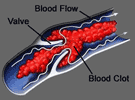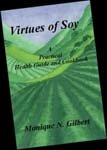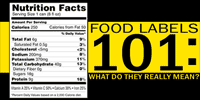Looking for an easy and natural way increase your vitality and improve your overall well-being? Try eating more fiber!
The average American only gets about half the amount of fiber they need everyday for their body to function optimally.
According to the American Heart Association (AHA), fiber helps lower cholesterol and is important for the health of our digestive system. Both the AHA and the National Cancer Institute recommend that we consume 25 to 30 grams of fiber daily.

Different Forms Of Fiber
Dietary fiber is a transparent solid complex carbohydrate that is the main part of the cell walls of plants. It has two forms:
- Soluble
- Insoluble
 Soluble Fiber
Soluble Fiber
- Soluble fiber may help lower blood cholesterol and reduce the risk of heart disease and stroke.
 Insoluble Fiber
Insoluble Fiber
- Insoluble fiber provides the bulk needed for proper functioning of the stomach and intestines. It promotes healthy intestinal action and prevents constipation by moving bodily waste through the digestive tract faster, so harmful substances don't have as much contact with the intestinal walls.

Am I Eating Enough Fiber?
Unfortunately, many people are not eating this much fiber, which is causing serious cardiovascular health concerns. Recently the AHA and the FDA (Food and Drug Administration) confirmed that coronary heart disease is the leading cause of death in the United States, killing more people than any other disease. It causes heart attack and angina (chest pain).
A blood clot that goes to the heart is considered a heart attack, but if it goes to the brain it is a stroke. The AHA ranks stoke as the third most fatal disease in America, causing paralysis and brain damage.
 |
Blood Clots A blood clot, also known as a thrombus, is the final product of blood coagulation, through the aggregation of platelets and the activation of the humoral coagulation system. A blood clot, also known as a thrombus, is the final product of blood coagulation, through the aggregation of platelets and the activation of the humoral coagulation system.
Coagulation is an important process the body uses to stop bleeding. A damaged blood vessel wall is covered by a fibrin clot to stop hemorrhage and aid repair of the damaged vessel. Disorders in coagulation can lead to increased hemorrhage and/or thrombosis and embolism. |
 |
 |
||
Eating a high-fiber diet can significantly lower our risk of heart attack, stroke and colon cancer. A 19-year follow-up study reported in the November 2001 issue of Archives of Internal Medicine indicated that increasing bean and legume intakes may be an important part of a dietary approach to preventing coronary heart disease.
Beans and legumes are high in protein and soluble fiber. Another study reported in the January 2002 issue of the Journal of the American College of Cardiology also suggests that increasing our consumption of fiber-rich foods like whole grains, fruits and vegetables, can significantly lower the risk of heart disease.
Additionally, results from recent studies at the American Institute of Cancer Research indicate high-fiber protein-rich soy foods, such as textured soy protein (also known as TVP) and tempeh, help in preventing and treating colon cancer.
 |
||||
 |
|
 |
||
 |
||||
Whole beans, soybeans and other legumes are excellent sources of fiber. A 1 cup serving of cooked navy beans contains about 19 grams of fiber!
Always read the Nutrition Facts label to find out the amount of, and the type of, fiber contained in any particular food. To help you achieve your daily allotment of fiber, here is a list of various foods with their fiber content.
 |
||||
 |
|
 |
||
 |
||||

Examples Of Dietary Fiber:
| Examples Of Dietary Fiber | ||||||||||||||||||||||||||||||||||||||||||||||||||||||||||||||
|
Author Bio
 Monique N. Gilbert, B.Sc. is a Health, Nutrition, Weight-Loss and Lifestyle Coach, Certified Personal Trainer/Fitness Counselor, Recipe Developer, Freelance Writer and Author of Virtues of Soy: A Practical Health Guide and Cookbook.
Monique N. Gilbert, B.Sc. is a Health, Nutrition, Weight-Loss and Lifestyle Coach, Certified Personal Trainer/Fitness Counselor, Recipe Developer, Freelance Writer and Author of Virtues of Soy: A Practical Health Guide and Cookbook.
You can contact Monique through her web site at www.MoniqueNGilbert.com
Monique has received international recognition for helping people get healthy, feel better, look younger and live longer.
She has offered guidance in natural health, nutrition, fitness, weight and stress management since 1989. Through her coaching program and writings, Monique motivates, inspires and teaches how to naturally enhance your health, happiness, energy and longevity with balanced nutrition, physical activity and tranquil living environments.
Copyright © Monique N. Gilbert - All Rights Reserved
References:
- "Legume consumption and risk of coronary heart disease in US men and women: NHANES I Epidemiologic Follow-up Study." Bazzano, L. A., He, J., Ogden, L. G., Loria, C., Vupputuri, S., Myers, L., Whelton, P. K., Archives of Internal Medicine 2001 Nov 26;161(21):2573-2578.
- "A prospective study of dietary fiber intake and risk of cardiovascular disease among women." Liu, S., Buring, J. E., Sesso, H. D., Rimm, E. B., Willett, W. C., Manson, J. E., Journal of the American College of Cardiology 2002 Jan 2;39(1):49-56.
- "Virtues of Soy: A Practical Health Guide and Cookbook" by Monique N. Gilbert, Universal Publishers, 2001, pp. 11, 18, 24.


